
Memento Mori: 1 2 3 4 5 6 <<First
Memento Mori in the Golden Age of Piracy, Page 6
Memento Mori and Pirate Flags
It is sometimes said that that pirate's greatest weapon was his flag. Pirates would obviously prefer to take a ship without a fight over one that could cost lives and ammunition, so the pirate flag was a powerful weapon. The goal of a pirate's flag (or colors) was to strike fear into the heart of the enemy and memento mori symbols which reminded the pirate's prey of their mortality could help do that.
Memento Mori and Pirate Flags - Tactical Considerations
The use
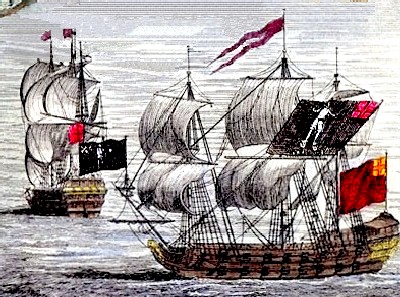
Bartholomew Roberts' Royal Fortune and Great Ranger
Off the
African
Coast,
Flying a Variety of Flags and Pennants, From the
General History
of the Pyrates
(1724)
of flags during the golden age of the pirates was more complicated than just a couple of yards of fabric flown from the main mast. A ship would have an assortment of flags, jacks, standards and pennants which would indicate their intent, their country and other information. The inventory of a pirate ship captured by Richard Appleton in 1718 included "1 black flagg, 1 Red flagg,
2 Ensignes, 2 pendants, [and]
1 Jack"1. The black and red flag are obvious pirate standards, the ensigns are flags which indicated the nation the ship hailed from (or other information such as which squadron a military ship belonged to), the pendants or pennants were long, thin triangular flags flown from the masthead on military ships to indicate things about the status or intent of the ship and the Jack is a small flag flown at the bow, normally indicating nationality.
Lest it seem that pirates relied on a single flag as is often seen in the movies, a contemporary account of Bartholomew Robert's ship coming into Trepassi Harbor (west of Cape Race in the southwest corner of Newfoundland) details the arrangement of his flags, as having "English Colours flying, their Pirate Flagg at the Topmast-Head, with Deaths Head and Cutlash"2. Another period account of Roberts attack of a ship lists "a St. George's Ensign, a black Silk Flag flying at their Mizen-Peek, and a Jack and Pendant of the same"3.
Many warships, privateers and pirates kept a supply of flags of different countries' on hand so that they could approach a targeted ship as a compatriot. This allowed them to get close before declaring their intention to take the ship, possibly saving a long and difficult chase at sea. "Legitimate rovers [privateers and warships] were permitted to chase under any nation’s colors, but were
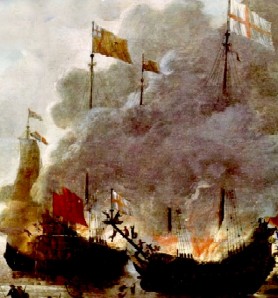
Artist: Jan Van Leyden
Ships Attacking With Flags and Pennants Flying,
The Battle in the Medway (1667)
supposed to attack only under their own. French sea ordinances, typical of those followed by European nations, permitted a vessel to chase under any colors, but required that true colors be hoisted before the actual attack, that is, before firing a shot – although waiting until the last possible moment was entirely legitimate."4
Of course, such rules did not apply to pirates, who could fly under whatever colors they decided best suited their purposes. However, Benerson Little does point out that by the golden age of pirates, deception using flags was so common that it had lost much of its effectiveness. He explains that "context was critical. Not only must a vessel's type or characteristics be considered [to determine what country it hailed from]... but also its location and behavior, and even so, it could still be impossible to determine nationality."5
Nor would a ship run around with their flags flying unless there was a reason. Little explains that "although colors [flags] were intended as a means of identifying ships, in practice a lookout seldom saw colors when he espied a ship, even at closer ranges. Flags were expensive, they faded and wore out if flown continually, they could be damaged by strong weather, and flying them added nothing to the speed or handling of a ship."6 So a pirate probably didn't even raise his flag until he was close to his prey and ready to take them.
1 "Inventory of a pirate sloop Minutes of the Provincial Council of Pennsylvania, vol. III", Pirates in Their Own Words, Ed Fox, ed., p. 375; 2 "117. Extract from the Boston News-Letter. August 22, 1720", Privateering and Piracy in the Colonial Period Illustrative Documents, John Franklin Jameson, ed., p. 317; 3 Captain Charles Johnson, General History of the Pyrates, 3rd Ed., p. 258; 4 Benerson Little, The Sea Rover's Practice, p. 116; 5 Little, p. 117; 6 Little, p. 111
Memento Mori and Pirate Flags - Flag Colors
"The boatswain then asked what colours they should fight under, and advised black as the most terrifying..." (Captain Charles Johnson, The History of the Pirates, p. 14-5)
The color of a pirate's flag was probably as important as any emblem it might have upon it. Color was much easier to spot at sea, where the wind conditions may not be favorable to whipping the flag and revealing the emblems that were on it. Two colors of flags were commonly used by pirates to indicate their intent during a fight: red and black.
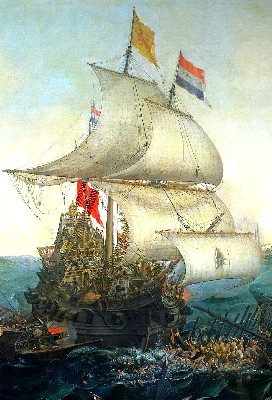
Artist: Hendrik Cornelisz Vroom
Dutch Ship Running Down Spanish Galleys (1617 )
The red flag has a broader meaning than the black. It was brought out by an attacker when the ship they were chasing had refused to surrender without a fight to indicate that no quarter [mercy] would be shown if they were caught. It could also be used in a more general sense to suggest that a ship refused to give or receive mercy. Benerson Little also says that it can be used "as an indication of undaunted courage."1
The red flag was not limited to use by pirates, but could be employed by any aggressor including men-of-war and privateers. Little suggests out that was also referred to as "the 'bloody banner,' 'bloody flag,' 'bloody colours,' or 'blood red colloures' by English-speaking peoples"2. This seems plausible, although in some of the period texts where the adjective 'bloody' is used, it could having a different meaning than red, referring instead to the bloodiness of the pirates' actions.
For example, in a letter by Captain John Mackra, he explains that while he was fighting with Captains Edward England and John (Richard) Taylor, the pirates had "their black and bloody Flags hanging over us, without the least Appearance of escaping being cut to Pieces."3 This could be taken one of two ways: either 1) Mackra was called black flag bloody (as in 'bloodstained') or 2) the pirates were flying both red and black flags when they attacked. Mackra does suggest that the pirates intended to show them no quarter, possibly supporting the idea that the pirates had red flags out in addition to the black.
Several pirate records refer to a red flag. These include Joseph Man's account of pirate Lewis Guittar who "hoisted up blood red Colloures and refused to submit"4, John (Richard) Taylor's crew, who, when faced with a fleet flying the English flag, "replied with Red"5 and Robert Culliford's crew, who, as they were going into battle and saw the enemy's flags, "hoisted theirs which were the Union Jack, and let fly a Broad Red Pendant, at their masthead."6 Another account of some buccaneers careening their ship explains that they were warned by local natives that "the Spaniards had tolde them [the natives] if any shipps came in that had any thing of redd in their collers [colors - flags], that thay should have a caire and not come on borde of them nor lett us see them, telling them that wee would kill them"7.
Captain Charles Johnson's books generally don't refer to red flags, but they do mention "bloody" flags a couple times. In the account of Stede Bonnet's standoff with Colonel William Rhett, Johnson explains, "The Pyrates made a Wiff [whiff – a hoisted signal]
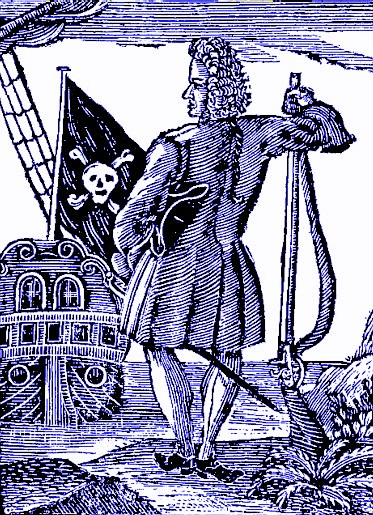
Stede Bonnet With a Skull and Crossed Bones Flag, From The
General
History of the Pyrates, (1725) - Note that although this
image dates to
the golden age of the pirates, it was drawn by
someone who almost
certainly
never
saw Bonnet or his flag.
in their bloody Flag, and beckoned several Times with their Hats in Derision to the Colonel's Men"8. In the account of pirate Captain John Halsey, Johnson explains that the pirates "gave chase, came up with her, hoisted the bloody flag at the main-mast-head, [and] fired one single gun"9.
Red flags aside, the most widely supported color for a pirate flag was black. This is typically referred to as 'the black Flag' or 'the black Colours', although period accounts also refer to it as "a pyratical black Flag"10, "a black Jack"11 and "a black Ensign"12.
Many of the golden age pirates are identified as having flown black flags including Edward Teach [Blackbeard]13, Stede Bonnet14, Charles Vane15, Howell Davis16, Oliver Levasseur [Oliver de la Bouche]17, Walter Kennedy18, Bartholomew Roberts19, George Lowther20, Thomas Tew21, John Martel22, Edward Low23, Francis Spriggs24, Richard Worley25, Emanuel Wynne26 and Samuel Bellamy27.
Black has long been associated with death, dating back to ancient Rome. In the 2nd century BC, Roman magistrates wore a dark toga, called a toga pulla, to funeral ceremonies. In Roman poetry, death was called the hora nigra, the black hour.28 So black has definite memento mori overtones which are particularly relevant to the pirate's intent in flying such a flag.
In addition to flags identified as being red, bloody and black, several flags mentioned in the period documents are simply identified as "pyratical" flags or colors. Like the 'bloody' flag descriptor, the color of these 'piratical' flags is not entirely clear from the text. It is notable that several of the accounts that include 'piratical' flags also mention the same pirates using black flags. For example, Captain Charles Johnson's tale of Edward Low refers to both a black flag23 and "pyratical Colours"29. Johnson also explains in his section on George Lowther that as the crew readied their ship they "prepared black Colours"30. He later refers to Lowther as having "hoisted his piratical Colours"31 during a chase. Since no mention is made of Lowther's pirates preparing a red flag, it seems logical that the 'piratical Colours' were black, although this can't really be stated with certainty.
In addition to Low and Lowther, the pirates who are listed as using 'piratical' colors or 'pirate's' colors include Howell Davis32, Christopher Condent33, John Phillips34 and Charles Vane35. Both Davis and Vane are also said to have flown a black flag. Davis is also notable for having started his pirate career by having "hoisted a dirty Tarpawlin [tarpaulin], by Way of black Flag, they having no other"36, which is included here because it again references the black flag and because it is sort of humorous.
1,2 Benerson Little, The Sea Rover's Practice, p. 113; 3 "A Letter from Captain Mackra dated at Bombay, Nov. 16, 1720", cited by Captain Charles Johnson, General History of the Pirates, 3rd Ed., p. 120; 4 "101. Deposition of Joseph Man. [June 11, 1700.]", Privateering and Piracy in the Colonial Period Illustrative Documents, John Franklin Jameson, ed., p. 274; 5 "56. Richard Lazenby, a prisoner of John Taylor", Privateering and Piracy in the Colonial Period Illustrative Documents, John Franklin Jameson, ed., p. 278; 6 "64. The battle between the Dorrill and the Mocha", Pirates in Their Own Words, Ed Fox,, ed., p. 354; 7 "45. The Buccaneers on the Isthmus and in the South Sea.1680-1682", Privateering and Piracy in the Colonial Period Illustrative Documents, John Franklin Jameson, ed., p. 122; 8 Captain Charles Johnson, A General History of the Pyrates, 3rd Edition, p. 270; 9 Captain Charles Johnson, The History of the Pirates, p. 100; 10 Johnson, General History, 3rd Ed., p. 66 & 285; 11 "30. The Information of Alexander Thompson", Pirates in Their Own Words, Ed Fox,, ed., p. 142; 12 "59. Richard Hawkins’ account of his capture by Francis Spriggs", Pirates in Their Own Words, Ed Fox,, ed., p. 300; Johnson, General History, 3rd Ed., p. 344; 13 Johnson, General History, 3rd Ed., p. 72, 93 & "74. Lists of ships taken by pirates", Pirates in Their Own Words, Ed Fox,, ed., p. 386; 13 Johnson, General History, 3rd Ed., p. 94; 14 "22. David Herriot and Ignatius Pell on Blackbeard and Stede
Bonnet", Pirates in Their Own Words, Ed Fox,, ed., p. 94; 15 Johnson, General History, 3rd Ed., p. 147; Johnson, History of the Pirates, p. 218; 16 Johnson, General History, 3rd Ed., p. 185 & 187; "54. Edward Green", Pirates in Their Own Words, Ed Fox,, ed., p. 270; 17 Johnson, General History, 3rd Ed., p. 184 & 185; 18 "53. Thomas Grant", Pirates in Their Own Words, Ed Fox,, ed., p. 268; 19 Johnson, General History, 3rd Ed., p. 237, 250, 258, 267, 285, 292 & 292; "61. Bridstock Weaver and William Ingram", Pirates in Their Own Words, Ed Fox,, ed., p. 325; "75. The end of Bartholomew Roberts", Pirates in Their Own Words, Ed Fox,, ed., p. 351; "117. Extract from the Boston News-Letter", Privateering and Piracy in the Colonial Period Illustrative Documents, John Franklin Jameson, ed., p. 317; 20 Johnson, General History, 3rd Ed., p. 351 & 361; ; 21 Johnson, History of the Pirates, p. 74; 22 Johnson, History of the Pirates, p. 66; "30. The Information of Alexander Thompson", Pirates in Their Own Words, Ed Fox,, ed., p. 141, 142 & 143; 23 Johnson, General History, 3rd Ed., p. 377, 368, 369, 381 & 389; 24 Johnson, General History, 3rd Ed., p. 417; "59. Richard Hawkins' account of his capture by Francis Spriggs" , Pirates in Their Own Words, Ed Fox,, ed., p. 300; 25 Johnson, General History, 3rd Ed., p. 344; 26 "Jolly Roger", Wikipedia.com, gathered 10/15/14; 27 "21. The Whydah survivors tell their stories", Pirates in Their Own Words, Ed Fox,, ed., p. 87; 28 "Black", wikipedia.com, gathered 10/18/14; 29 Johnson, General History, 3rd Ed., p. 381; 30 Johnson, General History, 3rd Ed., p. 351; 31 Johnson, General History, 3rd Ed., p. 358; 32 Johnson, General History, 3rd Ed., p. 177; "73. Captain Davis on the African Coast", Pirates in Their Own Words, Ed Fox,, ed., p. 379; 33 Johnson, History of the Pirates, p. 124; 34 "47. John Fillmore's narrative", Pirates in Their Own Words, Ed Fox,, ed., p. 235; Johnson, General History, 3rd Ed., p. 399; 35 Johnson, General History, 3rd Ed., p. 141 & 145; 36 Johnson, General History, 3rd Ed., p. 177-8
Memento Mori and Pirate Flags - Flag Designs
This brings us to the images that appeared on the pirate flags during the golden age of piracy, many of which had an underlying memento mori aspect. Although popular culture suggests that all pirate flags included a set of crossed bones or swords surmounted by a skull, evidence for the period presents a much murkier picture.
The black flag with a skull and crossed bones does not seem to have been used until about 1700, well into the golden age of piracy. Before then, pirates typically used flags from the country of their birth, pretending to be privateers rather than pirates. (Privateers were privately owned ships who had received letters of the marque from a country. These allowed the privateer to plunder vessels who were at war with the country who issued the letter.) "Only with the Peace of Utrecht in 1713, and the subsequent rise of pirates whose rhetoric pretended no nationality did the black flag fly with any regularity."1
When it comes to the pirate flags themselves, most people think of the skull over crossed bones, or, if they've read up on the topic in popular modern literature, they may think of the flags seen below. Unfortunately, while some of these flag have images that appear accurate to period sources, many are either not supported or have been incorrectly identified.
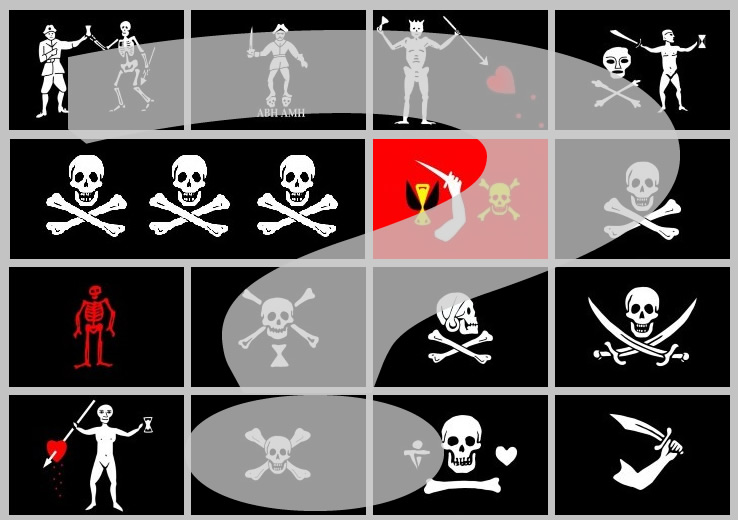 The Chart of Various Pirate Flags in the Popular Press - Some Supported By Documentation, Some Not (19th/20th c. Designs) |
Whatever these flags are, they are not images from the golden age of piracy. Benerson Little says "of most modern fanciful pirate flags,
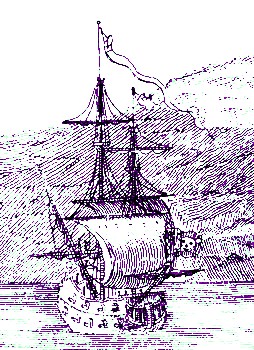
Artist: Joseph Nicholls
Blackbeard's Ship - The Skull Ensign Is
Seen Midway Up the Sail to the Left - Note
this image was drawn by someone who had
not actually seen Blackbeard's Ship (1736)
I've been unable to trace them earlier than a popular text from the 1950s."2 Ed Fox has tracked them back farther than that, finding them in FBC Bradlee's Piracy in the West Indies and its Suppression of 1923.3 While Dr. Fox hasn't been able to confirm the source, he learned about a possible older source for these illustrations in a discussion with fellow pirate historian Ken Kinkor. Kinkor referenced "an undated, unprovenanced manuscript containing images of the 'popular' pirate flags amongst the papers bequeathed to the National Maritime Museum, Greenwich, by Philip Gosse."4 (Gosse died in 1930s.)
The similarity in the design style of the above flags also suggests they were produced by a single source. If the flags had actually been made by several different pirate groups as is suggested, they would almost certainly feature different styles of skulls. (Consider the wide variations in skulls as seen on gravestones on page 3 of this article.) However, some of the designs are based on period descriptions of pirate flags from period sources. In fact, I have found sources for seven pirates with designs on their flags and pirate historian Ed Fox identified one more.
The most popular element in pirate flags with designs on them is the classic memento mori element of the skull. This makes sense given its instant identification with danger and death.
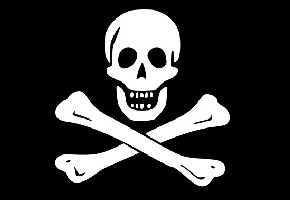
Flag Design, "Bones a-cross" Like Bellamy's
The account of pirate captain Richard Worley explains that he created "a black Ensign, with a white Death's Head in the Middle of it, and other Colours suitable to it."5 (The 'other Colours' comment is tantalizing, but what was colored and in what hues is impossible to say from that description.) Witness Edward Green reported that when his ship was spied by Howell Davis' pirates, they "hoysted up a black flag with a Death’s head and fired several Guns"6. So the simple skull on a black flag is well supported. A deposition from Thomas Knight in 1717 identifed the flags of pirates Kentish and Captain Edwards (aliases for Stede Bonnet and Edward Teach/Blackbeard) who "desired us to come on board, but seeing Death Head [on the flag] in the stern we refused it etc."7
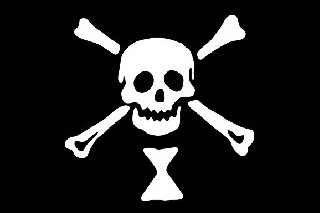
Flag Style Alleged to Be Used by Emanuel Wynn
Another popular element on a flag were crossed bones. You will recall from the previous pages that loose bones, sometimes crossed, were frequently used in late 17th and early 18th century memento mori art.
When chasing various prey ships, Thomas Baker, who was aboard Samuel Bellamy's ship, reported that "they spread a large black Flag, with a Death’s Head and Bones a-cross, and gave chase"8. Pirate Emanuel Wynne is reported to have had "a black flag with skull, crossbones, and hourglass" on it, the source of which is reportedly Captain John Cranby of the HMS Poole.9 This design incorporates another very popular memento mori element - the hour glass - indicating that time is running out.
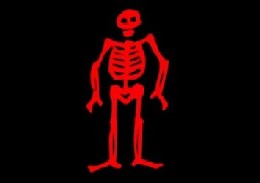
Flag Design of Edward Low
Another popular memento mori element, particularly in the 17th century, was the full skeleton. This appears on a few of the pirates' flags. Edward Low is described by Charles Johnson as hoisting "a black Flag, with the Figure of Death in red, at the Main-topmast Head"10.
An even more ornate version of the full skeleton is said to have been used by Francis Spriggs. He is reported by Richard Hawkins to have use a "black
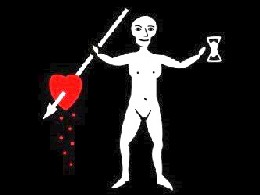
Flag Design Similar to That Described for Francis
Spriggs Using a Man Instead of a Skeleton
Ensign, in the Middle of which is a large white Skeleton, with a Dart in one Hand, striking a bleeding Heart, and in the other an Hour-Glass."11
The dart, or arrow, was yet another memento mori icon which indicated mortality. Hearts appear on some memento mori grave art as seen on page 3, although the bleeding heart being a rather violent version of this device, obviously designed to instill fear. Curiously, this design is not correctly drawn in the modern flags. It uses the figure of a man rather than a skeleton as detailed by Hawkins. It is also misidentified as being the flag of pirate John Quelch, when no such flag is known to have been used by Quelch.
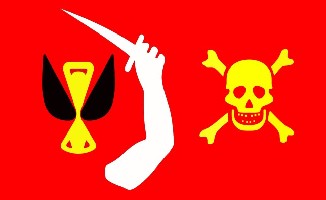
French-Described Pirate Flag
The rather fantastic red flag seen at left also appears to have some basis in the period literature. The flag is ascribed to pirate Christopher Moody, although Ed Fox points out that it "wasn't attributed to Moody until the 20th century, and Christopher Moody wasn't ever a captain"12. Dr. Fox says that the description of this flag actually comes from the book La Connoissance des Pavillons, printed in 1737 where it is labeled as a Pavillon des Corsaires (French for 'pirate flag').13 The book apparently does not indicate which pirate captain used this flag.
It does feature several memento mori elements including the skull and crossed bones and a winged hour glass (symbolizing the fact that time is flying away.) The arm holding a blade is an element added by the pirates which may suggest that no mercy will be shown.
Perhaps the most unique pirate flags from the period are those of Bartholomew Roberts. One account lists a "Pirate Flagg at the Topmast-Head, with Deaths Head and Cutlash"14. The death's head (or skull) is an obvious memento mori symbol while the cutlass is a pirate addition, probably suggesting there would be 'no mercy' like the previous flag.
Another account details both a flag and a jack (a small flag flown at the bow of the ship). "The Flag had a Death in it, with an Hour-Glass in one Hand, and cross Bones in the other, a Dart by it, and underneath a Heart dropping three Drops of Blood."15 This contains many of the classic memento mori symbols discussed above.
"The
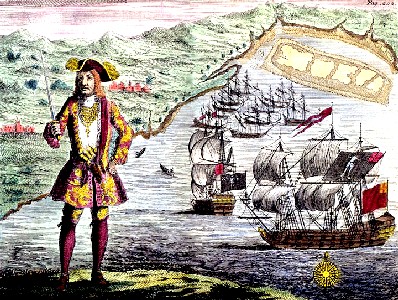
Bartholomew Roberts and
His Ships Off the African Coast, Flying a Variety
of Flags and Pennants, From the
General History of the Pyrates (1724)
Jack had a Man pourtray'd in it, with a flaming Sword in his Hand, and standing on two Skulls, subscribed A B H and A M H i.e. a Barbadian’s and a Martinican’s Head."16 This unique pirate flag is explained by Captain Johnson,
Roberts was so enraged at the Attempts that had been made for taking of him, by the Governors of Barbados and Martinico, that he ordered a new Jack to be made, which they ever after hoisted, with his own Figure pourtray'd, standing upon two Skulls, and under them the Letters A B H and A M H, signifying a Barbadian's and a Martinican's Head, as may be seen in the Plate of Captain Roberts.17
The plate of Captain Roberts that Johnson refers to can be seen above. This image has been hand-colored by someone other than the book's author. [The image at the top of this page is the same one cropped to focus on the ships and the flags.] Note the difference in size between the flag and the jack.
Another one of Robert's flags, recovered after Roberts had been killed and the pirates defeated, is described as having "the Figure of a Skeleton in it, and a Man pourtray'd with a flaming Sword in his Hand, intimating a Defyance of Death it self."18 Here, the skeleton is the only memento mori element and the man fighting him actually suggests the opposite meaning of memento mori ("remember you will die").
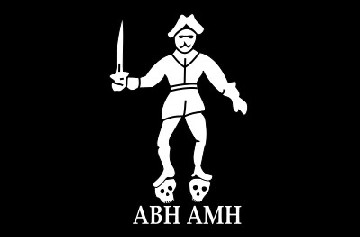 Roberts' Pirate Standing on a Barbadian and Martinican Skulls. Although the Flag is Described in the Text as Flaming, This Does Not Seem to Be the Case in This Design. |
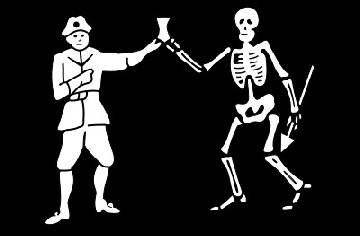 This is Supposed To Be Another One of Robert's Flags. It Has This is Supposed To Be Another One of Robert's Flags. It Has Elements From Two of the Flags Described in Period Texts, But Is Not Completely Representative of Either of Them. |
These are the only flags that can be attested to in the period descriptions. (And the last one is not exactly right as explained in its description.) The other flags in the chart of flags - those attributed to Stede Bonnet, Henry Every, Thomas Tew, Blackbeard, John Quelch, Christopher Condent, and John Rackham - are not supported by period documents. Ed Fox explains that he has done extensive research into them and has not yet found any support for them.19
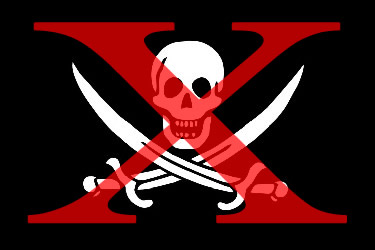
While a Popular Pirate Flag Image, This Is Not Supported By Evidence
When discussing these flags, Dr. Fox explains that "some of them are stylistically unlikely: the bandanna and earring of Every's flag don't fit our best knowledge about pirate appearance, and would be unusual features on a flag of the period in any case; the "devil" on Blackbeard's flag does not look like an 18th century representation of the Devil, etc."20
It is possible, even likely, that there were other flags with designs on them from the golden age of piracy. Many of the descriptions of flags in period documents rely on people's recollections of what the flags looked like, probably as described years after they saw the actual flag.
In addition, the authors didn't always give very complete descriptions. For example, while Captain Johnson gives vivid descriptions of Bartholomew Robert's flags, he more often simply refers to Roberts' flags as being black flags or black colors.21 So it is possible that there were other designs that were not described, but this cannot be proven. The burden of proof of such other flags would thus fall on the person asserting them to be accurate.
However, of the flags we can prove existed, there are multiple memento mori symbols in them, suggesting how widely understood and accepted memento mori was during the golden age of the pirates.
1 Benerson Little, The Sea Rover's Practice, p. 113; 2 Benerson Little, Response to "Why did pirates even have flags?", reddit.com, 10/2/14; 3,4 Ed Fox, Authentic Pirate Living History Group, Augest 27, 2014, Facebook, gathered 10/2/14; 5 Captain Charles Johnson, General History of the Pirates, 3rd Ed., p. 344; 6 "54. Edward Green", Pirates in Their Own Words, Ed Fox,, ed., p. 270; 7 "The Deposition of Thos. Knight, 30th November 1717", CSP Colonial, America and West Indies, 1717-1718. 298ii; 8 "21. The Whydah survivors tell their stories", Pirates in Their Own Words, Ed Fox,, ed., p. 87; 9 "Jolly Roger", wikipedia, gathered 10/15/14; 20 Johnson, General History, 3rd Ed., p. 389; 11 "59. Richard Hawkins’ account of his capture by Francis Spriggs", Pirates in Their Own Words, Ed Fox,, ed., p. 300; 12,13 Ed Fox, Authentic Pirate Living History Group, Augest 27, 2014, Facebook, gathered 10/2/14; 14 "117. Extract from the Boston News-Letter", Privateering and Piracy in the Colonial Period Illustrative Documents, John Franklin Jameson, ed., p. 317; 15,16 Johnson, General History, 3rd Ed., p. 258; 17 Johnson, General History, 3rd Ed., p. 243-4; 18 Johnson, General History, 3rd Ed., p. 273-4; 19,20 Ed Fox, Authentic Pirate Living History Group, Augest 27, 2014, Facebook, gathered 10/2/14; 21 Johnson, General History, 3rd Ed., p. 237, 250, 258, 267, 285, 292 & 292; "61. Bridstock Weaver and William Ingram", Pirates in Their Own Words, Ed Fox,, ed., p. 325; "75. The end of Bartholomew Roberts", Pirates in Their Own Words, Ed Fox,, ed., p. 351; "117. Extract from the Boston News-Letter", Privateering and Piracy in the Colonial Period Illustrative Documents, John Franklin Jameson, ed., p. 317

